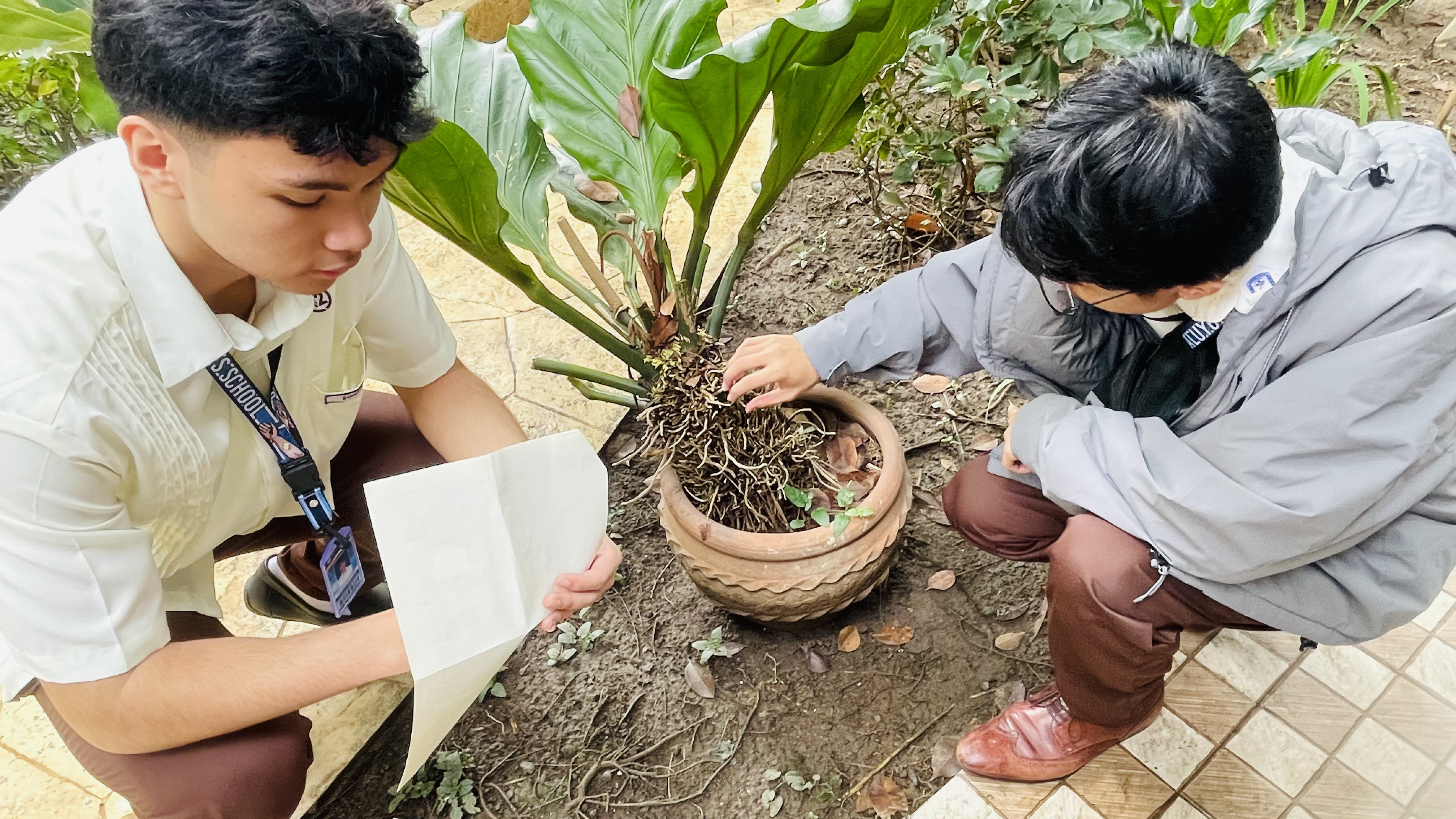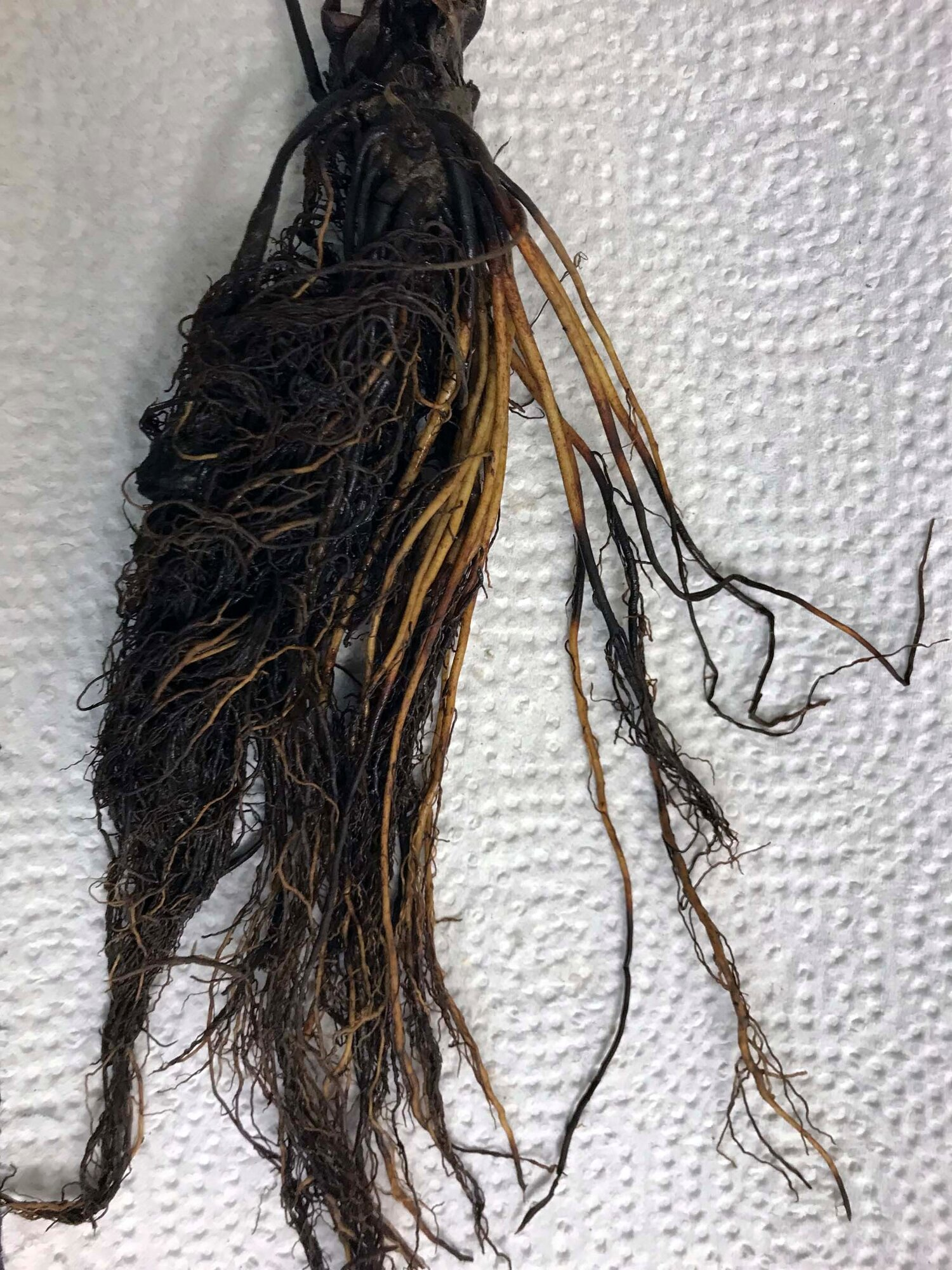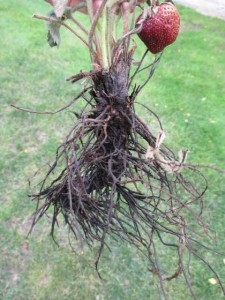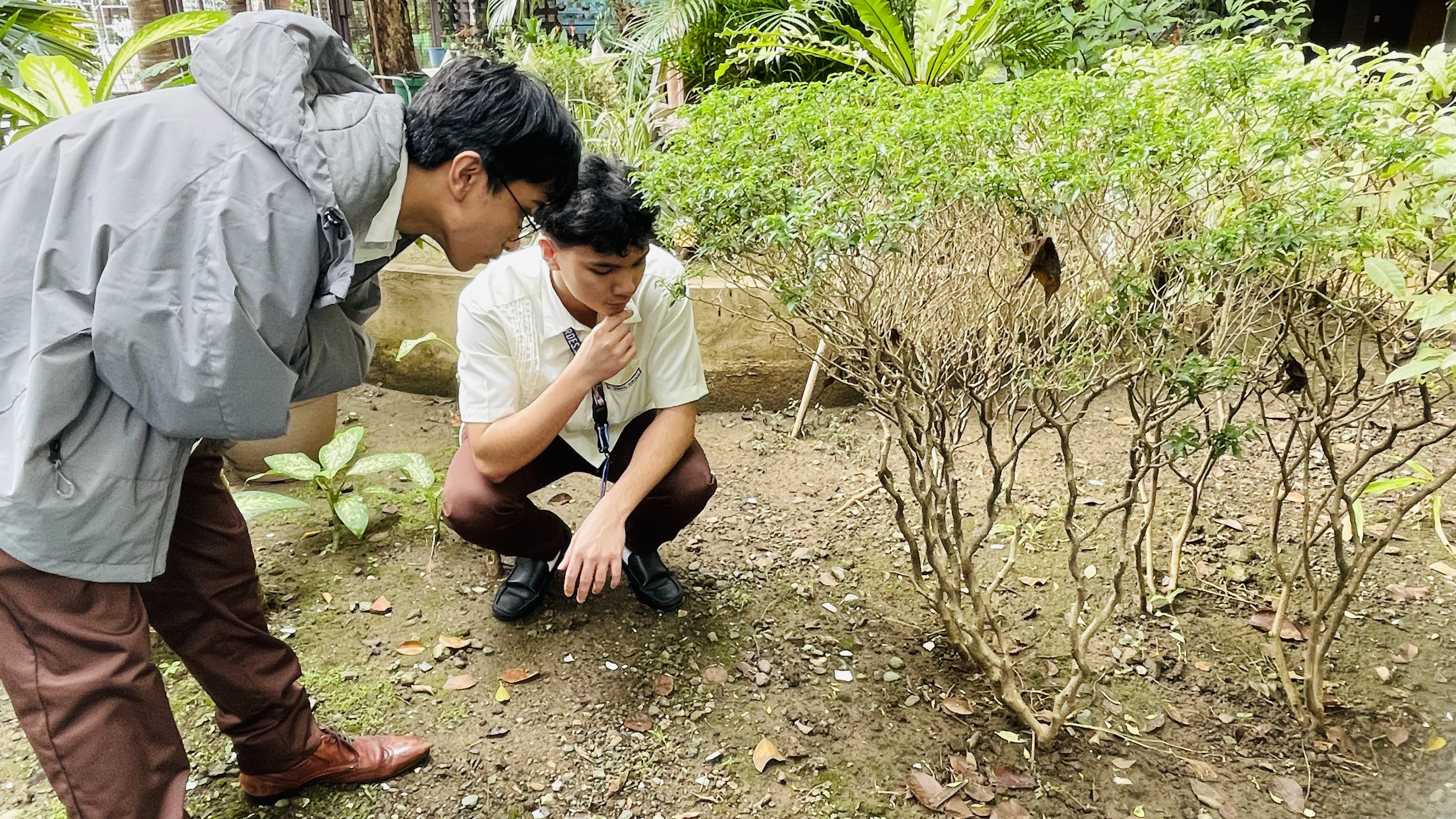About Thielaviopsis basicola
 Thielaviopsis basicola is a plant-pathogen fungus responsible for black root rot, a disease affecting a wide range of plants, particularly ornamentals and some agricultural crops. Some symptoms include root lesions, plant stunting and wilting, defoliation, and crown swelling. Infected plants have the appearance of dark brown or black lesions on its roots, the plants roots cannot properly absorb water and nutrients, leaves start shedding, and swelling of the crown may occur on the stem. It primarily reproduces asexually through two types of spores: endoconidia and chlamydospores. The fungus infects the roots through natural openings or wounds, especially if the plant is in wet soil. Once inside the plant, it establishes biotrophic feeding structures before transitioning to a necrotrophic phase, where it secretes enzymes to break down plant tissues in nutrients. To manage this disease, myclobutanil and acibenzolar-S-methyl are particularly effective fungicides for cotton plants while carbendazim and dithane M-45 are effective in tobacco plants.
Thielaviopsis basicola is a plant-pathogen fungus responsible for black root rot, a disease affecting a wide range of plants, particularly ornamentals and some agricultural crops. Some symptoms include root lesions, plant stunting and wilting, defoliation, and crown swelling. Infected plants have the appearance of dark brown or black lesions on its roots, the plants roots cannot properly absorb water and nutrients, leaves start shedding, and swelling of the crown may occur on the stem. It primarily reproduces asexually through two types of spores: endoconidia and chlamydospores. The fungus infects the roots through natural openings or wounds, especially if the plant is in wet soil. Once inside the plant, it establishes biotrophic feeding structures before transitioning to a necrotrophic phase, where it secretes enzymes to break down plant tissues in nutrients. To manage this disease, myclobutanil and acibenzolar-S-methyl are particularly effective fungicides for cotton plants while carbendazim and dithane M-45 are effective in tobacco plants.
Common Species Affected

T. basicola has a host range of more than 230 species and is commonly found on plants of the Fabaceae, Malvaceae, Solanaceae and Cucurbitaceae families. Examples are cotton, groundnut, bean, chicory, carrots, citrus, tomato and pineapple . Ornamental plant species affected include pansies (Viola carnula), sweet pea (Lathyrus odoratus) and Nemesia.
One major crop that is affected by Thielaviopsis basicola is cotton. In the United States alone, between the years 1995 and 2005, the total annual loss in revenue due to diseases in the cotton crop was $897 million. Thielaviopsis basicola was a significant contributor to that economic loss.
Additionally, cotton, carrot, lupin, cabbage, clover, and tobacco are all crops that can suffer from black root rot. Some important ornamental crops affected by black root rot include: Begonia sp. Daphne cneorum, poinsettia, African daisy, pansy, marigold, and petunia, and more.
Effects
It has been observed that black root rot can delay plant maturity for up to a month and result in over a 40% yield reduction in the affected crop. Surveys taken in 2010 and 2011 of Australian agriculture statistics reported black root rot to be present in 93% of farms and 83% of fields studied. Of the fields affected, yield losses have reached 1.5 bales per acre. The national average of cotton production per hectare in Australia is about 10 bales, so a loss of 1.5 bales per acre (or roughly 3 bales per hectare) to black root rot adds up to a significant loss.
Symptoms
Common symptoms include yellowing of the plant, defoliation, stunting or wilting, as well as red brown lenticels and swelling of the crown. The fungus produces black spores in roots that when abundant cause the black lesions that are typical of black root rot.
Prevention
The disease is difficult to manage once it has been established, preventing the infection for T. basicola is the best way to mitigate the pathogen. Fungicides are most effective when used preventatively or at first sign of disease. Fungicides can not compensate for poor sanitation or environmental controls. Fungicides should be used at first sign of disease, and should be used in combination with the cultural controls noted below.

Maintain a soil pH below 5.6.
Remove and destroy all diseased plants.
Use soil-less media when possible.
Sterilize all equipment.
Keep work areas clean.
Fungus gnats and shore flies may be vectors. Control these pests to minimize spread of the fungus.
Water in a manner that minimizes splashing of soil.
Furthermore, to avoid further contamination of plants and potting media, greenhouse floors and walkways should be lightly misted with water to cut down on airborne dust transmission of T. basicola during cleaning operations. At the end of the growing season, doing a thorough clean-up of the greenhouse can be beneficial because it reduces the possibility of the fungus surviving as a resistant chlamydospores on the soil floor and in wooden benches.
History
Thielaviopsis basicola was discovered in the mid-1800s and is still a major plant pathogen affecting ornamental and agricultural plants in over 31 countries around the world. There was initial confusion around the surrounding identity of these species until it was resolved in 1912 when all names were reduced to synonymy with the name Thielaviopsis basicola. This resulted from Massee (1912) recognizing that Milowia nivea, the species that he had described, and Torula basicola described by Berkeley & Broome (1850), represented the same fungus. Later the same year, Ferraris (1912) recognized that Helminthosporium (= Clasterosporium) fragile and Torula basicola represented a single fungus. However, he also recognized that the structures produced by these species resembled those of species in Thielaviopsis more than those of Torula. Consequently he synonymized Torula basicola (syn. = Milowia nivea) and Helminthosporium (= Clasterosporium) fragile under the new name Thielaviopsis basicola.







 A disease is described as an abnormal condition that negatively affects the structure or functions of all or one part of an organism, but is not caused by external injury. There are numerous types of diseases and are often known as medical conditions that are associated with specific signs and symptoms. A disease can be caused by pathogens or internal dysfunctions. For example, internal dysfunctions produce immunodeficiency, hypersensitivity, allergies, and autoimmune disorders. In humans, the term “disease” is used broadly and refers to any condition that “causes pain, dysfunction, distress, social problems, or death to the person affected, or may cause problems for people in contact with the person. It sometimes includes injuries, disabilities, disorders, syndromes, infections, isolated symptoms, deviant behaviors, and atypical variations of structure and function, while in other contexts and for other purposes these may be considered distinguishable categories. There are numerous different types and terms for diseases, for example, terminal diseases guarantee an individuals death such as AIDS, incurable diseases are diseases without a cure but can be treated sufficiently for it to have little to no impact on quality of life. Hereditary diseases are caused by hereditary genetic mutations that may run within a family, idiopathic diseases have an unknown cause or source, illnesses refer to the experience of an individual of their disease, and more.
A disease is described as an abnormal condition that negatively affects the structure or functions of all or one part of an organism, but is not caused by external injury. There are numerous types of diseases and are often known as medical conditions that are associated with specific signs and symptoms. A disease can be caused by pathogens or internal dysfunctions. For example, internal dysfunctions produce immunodeficiency, hypersensitivity, allergies, and autoimmune disorders. In humans, the term “disease” is used broadly and refers to any condition that “causes pain, dysfunction, distress, social problems, or death to the person affected, or may cause problems for people in contact with the person. It sometimes includes injuries, disabilities, disorders, syndromes, infections, isolated symptoms, deviant behaviors, and atypical variations of structure and function, while in other contexts and for other purposes these may be considered distinguishable categories. There are numerous different types and terms for diseases, for example, terminal diseases guarantee an individuals death such as AIDS, incurable diseases are diseases without a cure but can be treated sufficiently for it to have little to no impact on quality of life. Hereditary diseases are caused by hereditary genetic mutations that may run within a family, idiopathic diseases have an unknown cause or source, illnesses refer to the experience of an individual of their disease, and more.
 Plant diseases are the byproduct of pathogens and lethal environmental conditions. Fungi, oomycetes, bacteria, viruses, viroids, virus-like organisms, phytoplasmas, protozoa, nematodes, and parasitic plants are all examples of causing infectious diseases in plants that may reduce crop yield, restrict plant growth, wilting, necrosis, and other symptoms that can drastically affect the entire ecosystem. These pathogens have 5 main types of specific pathogenicity factors. First is the cell wall-degrading enzymes: They are used to break down a plants cell wall to release nutrients inside, toxins damage all plants, effector proteins which suppress the host plants defense processes, phytohormones to modify a plants growth, and exopolysaccharides that help the pathogen begin infection. Plant diseases can be managed because they can be detected using polymerase chain reaction (PCR) and crop rotation, which is the practice of growing a series of different types of crops in the same area, preventing a parasitic population from spreading further. Treating these diseases prevents food shortages, provides health benefits, and economic benefits.
Plant diseases are the byproduct of pathogens and lethal environmental conditions. Fungi, oomycetes, bacteria, viruses, viroids, virus-like organisms, phytoplasmas, protozoa, nematodes, and parasitic plants are all examples of causing infectious diseases in plants that may reduce crop yield, restrict plant growth, wilting, necrosis, and other symptoms that can drastically affect the entire ecosystem. These pathogens have 5 main types of specific pathogenicity factors. First is the cell wall-degrading enzymes: They are used to break down a plants cell wall to release nutrients inside, toxins damage all plants, effector proteins which suppress the host plants defense processes, phytohormones to modify a plants growth, and exopolysaccharides that help the pathogen begin infection. Plant diseases can be managed because they can be detected using polymerase chain reaction (PCR) and crop rotation, which is the practice of growing a series of different types of crops in the same area, preventing a parasitic population from spreading further. Treating these diseases prevents food shortages, provides health benefits, and economic benefits.
 With the help of chemistry, creating fungicides such as myclobutanil and acibenzolar-S-methyl and other non-toxic chemical treatments is possible. Researchers and scientists are continuously developing non-toxic and safe substances that are less susceptible to antimicrobial resistance in bacteria. These substances are specifically designed to treat plant pathogens, such as Thielaviopsis basicola. Fungicides are pesticides that are engineered to kill parasitic fungi or spores. Fungi can inflict significant harm on agriculture, leading to reductions in yield and quality, as well as financial losses. There are different types of fungicides, namely traditional fungicides, which are simple inorganic compounds like sulfur and copper salts; non-specific fungicides that target a general population of fungi; specific fungicides that target a specific biological process in the fungi, respiration, which are fungicides that target succinate dehydrogenase, a metabolically central enzyme; amino acid and protein synthesis; signal transduction; cell wall biosynthesis; and many more. Additionally, understanding the chemistry behind the creation of fungicides helps us acknowledge their environmental impact, as they can sometimes be toxic to plants and soil. We scientists and researchers study the inner workings of their chemical composition to develop safer alternatives that minimize ecological risk. It is important to apply these fungicides in order to protect a plant before it gets infected. It is similar to a vaccine in that it prevents disease, but cannot cure it. The following chemicals are common fungicide that prevents fungal diseases from affecting plants.
With the help of chemistry, creating fungicides such as myclobutanil and acibenzolar-S-methyl and other non-toxic chemical treatments is possible. Researchers and scientists are continuously developing non-toxic and safe substances that are less susceptible to antimicrobial resistance in bacteria. These substances are specifically designed to treat plant pathogens, such as Thielaviopsis basicola. Fungicides are pesticides that are engineered to kill parasitic fungi or spores. Fungi can inflict significant harm on agriculture, leading to reductions in yield and quality, as well as financial losses. There are different types of fungicides, namely traditional fungicides, which are simple inorganic compounds like sulfur and copper salts; non-specific fungicides that target a general population of fungi; specific fungicides that target a specific biological process in the fungi, respiration, which are fungicides that target succinate dehydrogenase, a metabolically central enzyme; amino acid and protein synthesis; signal transduction; cell wall biosynthesis; and many more. Additionally, understanding the chemistry behind the creation of fungicides helps us acknowledge their environmental impact, as they can sometimes be toxic to plants and soil. We scientists and researchers study the inner workings of their chemical composition to develop safer alternatives that minimize ecological risk. It is important to apply these fungicides in order to protect a plant before it gets infected. It is similar to a vaccine in that it prevents disease, but cannot cure it. The following chemicals are common fungicide that prevents fungal diseases from affecting plants. Thielaviopsis basicola is a plant-pathogen fungus responsible for black root rot, a disease affecting a wide range of plants, particularly ornamentals and some agricultural crops. Some symptoms include root lesions, plant stunting and wilting, defoliation, and crown swelling. Infected plants have the appearance of dark brown or black lesions on its roots, the plants roots cannot properly absorb water and nutrients, leaves start shedding, and swelling of the crown may occur on the stem. It primarily reproduces asexually through two types of spores: endoconidia and chlamydospores. The fungus infects the roots through natural openings or wounds, especially if the plant is in wet soil. Once inside the plant, it establishes biotrophic feeding structures before transitioning to a necrotrophic phase, where it secretes enzymes to break down plant tissues in nutrients. To manage this disease, myclobutanil and acibenzolar-S-methyl are particularly effective fungicides for cotton plants while carbendazim and dithane M-45 are effective in tobacco plants.
Thielaviopsis basicola is a plant-pathogen fungus responsible for black root rot, a disease affecting a wide range of plants, particularly ornamentals and some agricultural crops. Some symptoms include root lesions, plant stunting and wilting, defoliation, and crown swelling. Infected plants have the appearance of dark brown or black lesions on its roots, the plants roots cannot properly absorb water and nutrients, leaves start shedding, and swelling of the crown may occur on the stem. It primarily reproduces asexually through two types of spores: endoconidia and chlamydospores. The fungus infects the roots through natural openings or wounds, especially if the plant is in wet soil. Once inside the plant, it establishes biotrophic feeding structures before transitioning to a necrotrophic phase, where it secretes enzymes to break down plant tissues in nutrients. To manage this disease, myclobutanil and acibenzolar-S-methyl are particularly effective fungicides for cotton plants while carbendazim and dithane M-45 are effective in tobacco plants. 






